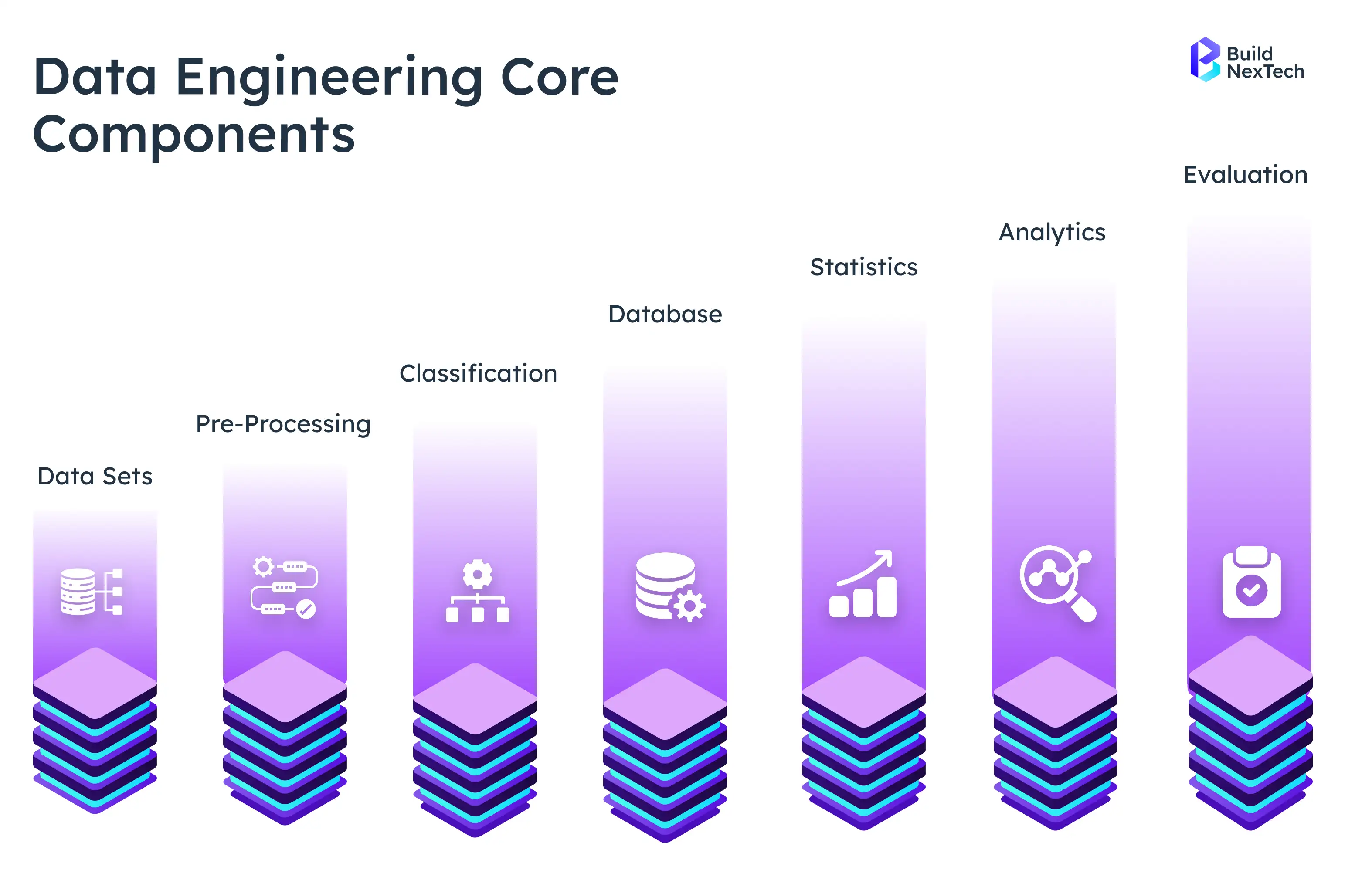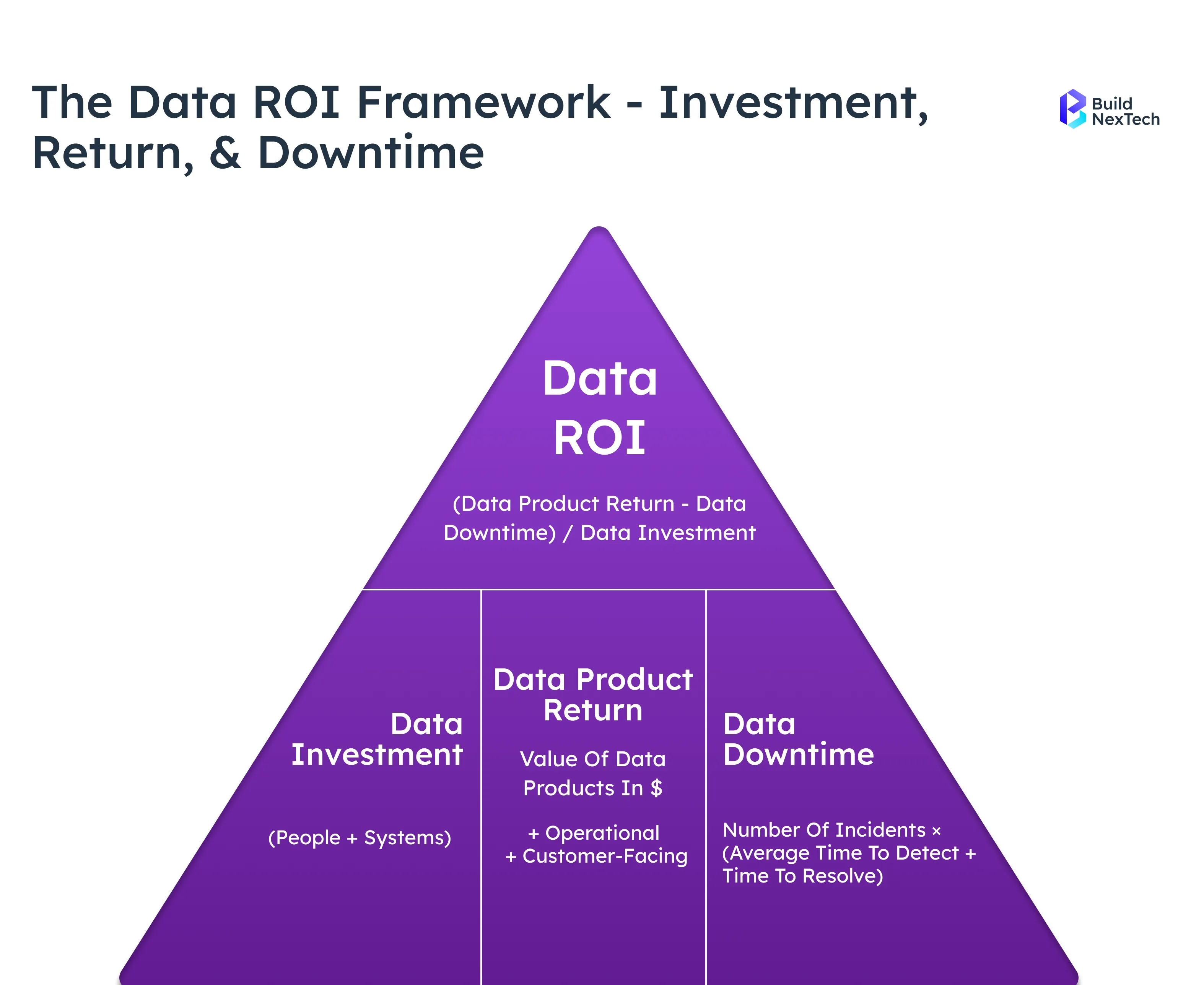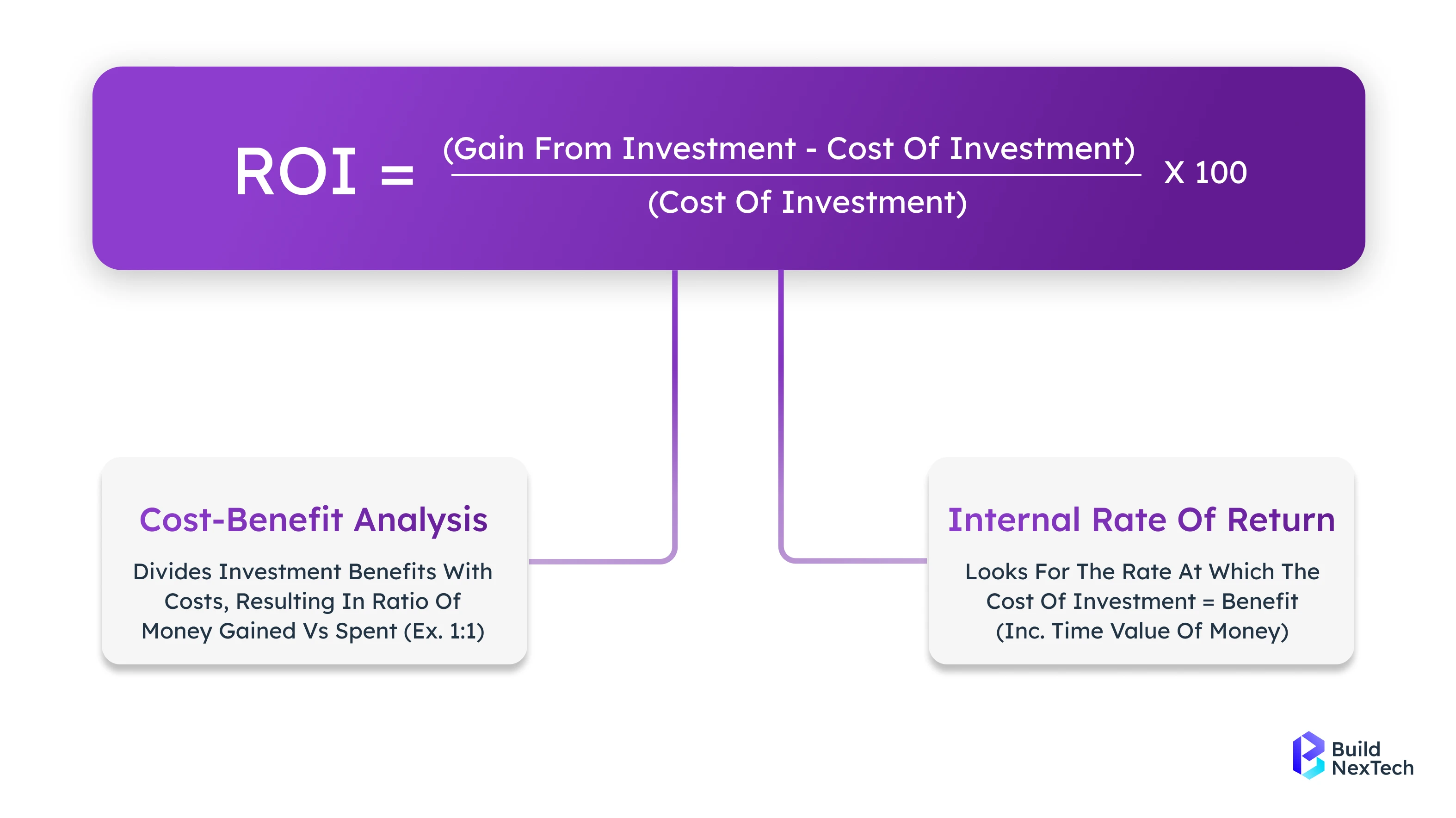In the modern business environment, companies are becoming more aware of the fact that data is not merely a tool of operation anymore but also a source of competitive advantage. However, lots of companies cannot use huge amounts of data to convert them into the reality of business. The task is not collecting the data, but developing an analytics-friendly environment that achieves measurable financial outcomes - a real high return on investment.
In this blog, we will explore:
- The principles and business value of data engineering.
- The best pillars of realization of the best return on investment by the best data systems.
- Data modeling, data visualization, and predictive insights role in business development.
- Measuring, quantifying, and maintaining data-based ROI.
- Practical views on the enhancement of the ROI of data initiatives.
BuildNexTech helps businesses create high-performance data ecosystems by combining advanced engineering practices with AI-driven automation and analytics-ready systems. We enable companies to turn their data into measurable ROI through modern data pipelines, cloud platforms, and intelligent automation.
Understanding Data Engineering
Contemporary companies are struggling with the problem of converting massive and heterogeneous data into operational intelligence. The solution to this lies in data engineering, where pipelines, architecture, and workflows are designed and optimized to ensure information is reliable and analytics-ready. It converts raw data into a strategic asset and source of efficiency, innovation, and quantifiable ROI.

What is Data Engineering?
In its simplest definition, data engineering can be described as the process of designing, building, and managing data systems that are efficient in the collection, processing, and storage of information. It offers the framework that underlies data analytics, predictive analytics, and AI/ML initiatives.
In other words, what is data engineering? It is the science that converts unstructured and raw data into a form of structured and actionable information. This involves the construction of data pipelines, data ingestion management, data quality management support, and analytics support by designing ETL/ELT or transforming data.
As cloud-based computing solutions, such as Google Cloud Platform, Microsoft Azure, and AWS, have emerged, the new data engineering incorporates real-time data, streaming analytics, and data lake modernization, giving an enterprise the ability to run data and information visualization at scale in real time.
Core Elements of Modern Data Engineering Architecture
Current-day data architecture is based on some of the following components:
- Information Ingestion: Gathering information regarding various data sources like ERP, CRM, IoT, social platforms, and so on.
- Data Pipelines: Automating the information of data flow by using high-speed data pipelines to transform and purify datasets.
- Data Storage: Considering cloud data warehouses such as Snowflake or Delta Lake as the means of secure and scalable storage.
- Data Modeling and Design: Organization of the data into logical structures that can be used to meet business objectives.
- Data Governance: This is to ensure compliance, lineage tracking, and data privacy with robust security systems.
The layers allow engineering data teams to operationalize knowledge, automatically report, and drive data analytics services throughout departments.
The Value of Specialized Data Engineering Expertise
Businesses are frequently faced with incompatible data storage, manual operations, and increasing costs of cloud infrastructure. Custom data engineering consulting is the solution to this gap through the application of established AI strategy, MLOps models, and data optimization practices to integrate data systems.
Data science feature engineering, AI development services, and Generative AI development services are the key areas of innovation accelerated by consultants so that the process of AI adoption may be strategic and scalable. The result is a measurable positive return on investment, reduced latency, and more efficient business operations.
Strategic Pillars for Maximizing Data ROI
Organisations require prioritised structures on data initiatives aligned to financial results to ensure the best return on investment of data initiatives. The subsequent strategic pillars constitute a clear roadmap to maximise data ROI:

Prioritizing Projects with the Highest Financial Impact
Any data initiative must have a measurable objective, be it a reduction in churn, better marketing, or automation of manual operations. By applying tools such as the return on investment model and the return on investment property calculator, expert consultants can see opportunities with a high potential of earning a high return on investment.
The following are just examples of projects that can be prioritised according to estimated returns and operational influence: projects that enhance customer engagement, projects that optimise supply chain resilience, and marketing return on investment ROI. Through financial modelling, firms will be in a position to determine the rate of the anticipated return on investment before it is executed.
Implementing Automated Data Quality and Observability
The accuracy of data has a direct influence on business. Event monitoring Data pipelines are constantly examined by automated observability frameworks driven by AI Agents and Agentic AI. This is to provide predictive analytics-ready and data modeling datasets that are trusted.
More sophisticated data quality control tools help reveal inconsistencies at the initial phase, whereas the framework of data governance and AI Governance supports adherence to the ISO standards, like ISO 42001. The outcome includes operational excellence, sustainability, and accelerated time to value.
The Strategy of Cloud Cost Optimization (FinOps)
Applications that consume large amounts of data on cloud platforms may be costly to the point of explosion. FinOps are used by professional consultants to manage the costs of EC2, take advantage of auto-scaling, and track data egress.
Methods such as workload right-sizing, cloud data migration, and storage tiering cut the waste. This plan will provide a safe return on investment, and it will also maintain a predictable cost base to keep on innovating analytics.
Data Modeling and Visualization — Transforming Data into Actionable Insights
Data modeling converts raw data to an analysis format, whereas visualization employs graphs and charts to bring out trends and patterns. Combined, they assist in transforming incomprehensible data into plain, actionable insights, which allows decision-making and optimization of strategies.
Designing Data Models for Business Questions
Good data and modeling practices are those that transform business questions into quantifiable forms. Consultants create tools for data modeling with the help of dbt or Erwin, and Lucidchart, and make them meet KPIs, such as sales conversion or campaign performance.
Accuracy is guaranteed by the data modeling process by way of normalisation, and data modeling and design provide flexibility for future growth. Real-time systems synchronisation via integration with data pipelines empowers the teams to respond to the question of why behind all trends.
Best Practices for Dashboarding and Data Storytelling
Organizations can transform analytics into business actions with the help of well-designed dashboards and data stories. Structured visualization techniques are applied by expert data engineering consultants who will make sure that all the charts or dashboards directly support ROI and strategic decision-making.
Best Practices Include:
- Set the Objective: Begin by setting up clear business goals - either monitoring marketing ROI, sales performance, or cost efficiency.
- Effective Preaching- Embrace Clarity and Context: Reduce the visuals to simple, consistent, and business-related.
- Add Interactive Visualization Hotspots: Utilize Power BI, Tableau, and Microsoft Fabric by providing dynamic and real-time dashboards.
- Connect Data to Decisions: In every data visualization, make sure there is a story and connect the insights to measurable outcomes.
- Encourage Data-Accessibility: Build dashboards to ensure that there is a culture of data-driven culture on teams by facilitating both technical and non-technical views to access data.
Measuring and Quantifying Data Engineering ROI
Determining ROI based on data engineering is no longer an abstract concept; it now requires specific metrics and financial validation. Consulting partners utilize tools and formulas, such as the return on rental investment calculator, the monthly return on investment, and the marketing return on investment formula, to accurately measure business value.
Calculating Return on Investment in Data Projects
The ROI in the data engineering projects can be calculated as follows:

As an example, it is possible to compute the rental return on investment or the average return on investment on automated ETL in terms of fewer human hours and increased throughput in data processing.
Entering the field of data analytics services through the use of AI software development services enables businesses to achieve a positive return on investment more quickly by increasing productivity and reducing cycle time.
Key Success Metrics and KPIs for Data Initiatives
Part of the measurable KPIs are:
- Less latency and downtime of data by automating pipelines.
- Quick time to value through analytics-ready systems.
- More accurate prediction with Predictive Analytics and machine learning algorithms.
- More marketing efficiency and the computation of what is return on marketing investment.
These measures will make the data engineering consulting results meet the financial goals of the board and could track the ROI of business units.
Success Stories: Metrics and Financial Outcomes
1. Financial Sector - Real Time Fraud Analytics
One of the global banks installed Google Cloud Platform and Microsoft Azure AI/ML data pipelines. They lowered the time of fraud detection from hours to seconds by automating the process of data ingestion and implementing machine learning models. The initiative yielded a 45% improvement in fraud prevention and delivered a positive return on investment within one quarter.
2. Retail - Marketing ROI Optimization
One of the data visualization customers is a multinational retailer that utilized these services and data modeling to track the performance of the campaigns. The company enhanced the efficiency of ad spend by 32 percent, as well as conversion by 18 percent, with the help of marketing return on investment formula dashboards developed on the basis of Power BI and AI-powered agents.
3. Manufacturing - Maintenance Prognostics
By developing AI services in conjunction with data analytics and predictive models, one manufacturer lowered machine downtime by a quarter. Predictive maintenance systems were used actively, predicting any upcoming failures through the use of Generative AI solutions and AI/ML development services, which provided the best return on investment in terms of saved operations and visibility of assets.
Conclusion:
The gap between technology potential and business performance is filled at Expert Data Engineering Consulting. With the help of data science, Artificial Intelligence, and cloud server usage, businesses will be able to unify systems, automate insights, and have a sustainable financial base.
Modern organisations that invest in data engineering on Google Cloud Platform and AI Strategy and Roadmap Development benefit in measurable ways, whether it is through optimising pipelines, improved visualisation, or enhanced marketing measurement, ultimately transforming raw data into profit.
BuildNexTech helps enterprises transform their businesses with data through end-to-end consulting, covering data integration, model optimization, AI-powered agents, and secure cloud infrastructure. Partner with BuildNexTech to turn your data ecosystem into a strategic engine of growth, innovation, and measurable ROI.
People Also Ask
How does effective data engineering drive business growth and innovation?
It streamlines data pipelines, improves data quality, and enables real-time analytics, driving faster business decisions and innovation across operations.
What are the key components of a successful data engineering strategy?
The main elements consist of the ingestion of data, modelling, governance, integration, and automation using scalable cloud solutions such as Google Cloud and Azure.
How can data modeling enhance business decision-making?
Correct data modeling and design are the interpretation of business aspirations into quantifiable understandings, aiding predictive analytics and informed choices.
Why is data visualization critical in maximising ROI?
Current data visualisation applications and dashboards assist in changing complicated analytics into actionable information that can directly enhance financial results.


























.webp)
.webp)
.webp)

